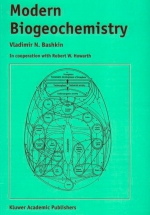Добрый день, Коллеги. Важное сообщение, просьба принять участие. Музей Ферсмана ищет помощь для реставрационных работ в помещении. Подробности по ссылке
Modern biogeochemistry
Biogeochemistry is becoming an increasingly popular subject in graduate education. Courses in ecology, geography, biology, chemistry, environmental science, public health, and environmental engineering all have to include biogeochemistry in their syllabuses to a greater or lesser extent. Humanity’s ever growing impact on the Environment, and the consequent local, regional, and global effect demand a profound understanding of the mechanisms underlying the sustainability of the biosphere and its compounds. The ideas of biogeochemistry about the universality of biogeochemical cycles involving the mass exchange of chemical elements between living organisms and the environment in the Earth’s surface appear to be quite productive in this high priority academic and scientific discipline. In biogeochemical cycling the active principles come from biota which global biological and geological activity alter slowly the biosphere’s compartments. On the other hand, the environment causes the living organisms evolve.
Biogeochemistry is the study of biological controls on the chemistry of the environment and geochemical regulation of ecological structure and function. Although the term was first used some 75 years ago, roots of this discipline can be traced to the earliest development of the natural sciences, before biology, geology, and chemistry became separate disciplines. Today biogeochemistry serves as a force of reintegration across these fields.
This textbook is aimed at generalizing the modern ideas of biogeochemical development during recent decades. Only a few textbooks are available for undergraduate and graduate students, however, as most books deal mainly with advanced research aspects of the subject. This book aims at supplementing the existing textbooks by providing a modern understanding of biogeochemistry, from evolutionary biogeochem-istry to the practical application of biogeochemical ideas as a human biogeochemistry, biogeochemical standards, and biogeochemical technologies.
The reader will start from the history of biogeochemistry, which is important in this science inspite of being relatively young. The names of V. Vernadsky, F. Clark, A. Vinogradov, G. Hutchinson, A. Fersman, V. Goldschmidt, V. Kovalsky, E. Degans, V. Kovda, D. Atkinson, G. Likens, S. Miller, V. Dobrovolsky and many other scientists who carried out the biogeochemical research in various countries have to be known to students. During the last 3.5–3.8 billion years the evolution of the Earth and biogeochemical cycles have been developing in parallel and consequently the ideas of evolutionary biogeochemistry (Chapter 2) provide a key to understanding of the modern atmosphere, biosphere, and hydrosphere. The biogenic depositions which are very important for our civilization, were formed during geological history under the active influence of biogeochemical cycles, and this item is also discussed in this text. The biogeochemical cycling of macro and trace elements is a crucial point of the textbook (Chapters 3 & 4). However, the main attention here is given to the description of natural regularities of global biogeochemical cycling. The conceptual ways of considering the interactions of element cycles such as stoichiometric aspects of nutrient uptake (and nutrient limitation of production), stoichoimetric aspects of nutrient recycling, thermodynamics as applicable to bacterial energetics (and the use of different electron acceptors), etc., are elucidated in Chapter 5. The description of regional biogeochemistry gives readers the possibility of understanding the qualitative and quantitative parameters of different cycles in different places of the Earth (Chapter 6). The text also presents a general understanding of the ideas of biogeochemical mapping. Although this has still not been carried out for the whole planet, some examples are shown, for instance, in North Eurasia. Soil-biogeochemical regionalization is considered as a key for the preliminary mapping on a continental scale (Chapter 7). As a complement to the biogeochemistry of natural ecosystems, environmental biogeochemistry is to show the pollution processes as a disturbance of natural biogeochemical cycles (Chapter 8). Human biogeochemistry is now developing in various countries. This is considered to be very important for understanding human illnesses, human diet, and human adaptation, and the relevant state of the art of human biogeochemistry is shown in Chapter 9. At present ecological standards and norms based on the understanding and simulation of biogeochemical cycles of different elements are forming in many countries. The critical load calculation and mapping are widely used in Europe, North America, and Asia. I think this would be of interest for students as well (Chapter 10).
This text is to a certain extent a summary of both scientific results of various authors and of classes in biogeochemistry, which were given to students by the author during the last 5–10 years in different universities. So we thank the many students of the Universities of Cornell, Moscow, Pushchino, Seoul, and Bangkok, who explored this subject initially without a textbook. The critical discussion and comments during these classes have provided us with the possibility of presenting this book.




